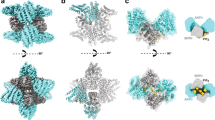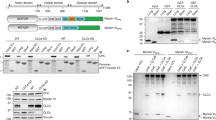Abstract
During endocytosis, clathrin and the clathrin adaptor protein AP-2 (ref. 1), assisted by a variety of accessory factors, help to generate an invaginated bud at the cell membrane2,3. One of these factors is Eps15, a clathrin-coat-associated protein that binds the α-adaptin subunit of AP-2 (4–8). Here we investigate the function of Eps15 by characterizing an important binding partner for its region containing EH domains9; this protein, epsin, is closely related to the Xenopus mitotic phosphoprotein MP90 (ref. 10) and has a ubiquitous tissue distribution. It is concentrated together with Eps15 in presynaptic nerve terminals, which are sites specialized for the clathrin-mediated endocytosis of synaptic vesicles. The central region of epsin binds AP-2 and its carboxy-terminal region binds Eps15. Epsin is associated with clathrin coats in situ, can be co-precipitated with AP-2 and Eps15 from brain extracts, but does not co-purify with clathrin coat components in a clathrin-coated vesicle fraction. When epsin function is disrupted, clathrin-mediated endocytosis is blocked. We propose that epsin may participate, together with Eps15, in the molecular rearrangement of the clathrin coats that are required for coated-pit invagination and vesicle fission.
This is a preview of subscription content, access via your institution
Access options
Subscribe to this journal
Receive 51 print issues and online access
$199.00 per year
only $3.90 per issue
Buy this article
- Purchase on Springer Link
- Instant access to full article PDF
Prices may be subject to local taxes which are calculated during checkout






Similar content being viewed by others
References
Robinson, M. S. The role of clathrin, adaptors and dynamin in endocytosis. Curr. Opin. Cell Biol. 6, 538–544 (1994).
Cremona, O. & De Camilla, P. Synaptic vesicle endocytosis. Curr. Opin. Neurobiol. 7, 323–330 (1997).
Kirchhausen, T., Bonifacino, J. S. & Riezman, H. Linking cargo to vesicle formation: receptor tail interactions with coat proteins. Curr. Opin. Cell Biol. 9, 488–495 (1997).
Benmerah, A., Begue, B., Dautry-Varsat, A. & Cerf-Bensussan, N. The ear of alpha-adaptin interacts with the COOH-terminal domain of the Eps 15 protein. J. Biol. Chem. 271, 12111–12116 (1996).
Benmerah, A.et al. AP-2/Eps15 interactions is required for receptor-mediated endocytosis. J. Cell. Biol. 140, 1055–1062 (1998).
Carbone, R.et al. eps15 and eps15R are essential components of the endocytic pathway. Cancer Res. 57, 5498–5504 (1997).
Iannolo, G.et al. Mapping of the molecular determinants involved in the interaction between eps15 and AP-2. Cancer Res. 57, 240–245 (1997).
Tebar, F., Sorkina, T., Sorkin, A., Ericsson, M. & Kirchhausen, T. Eps15 is a component of clathrin-coated pits and vesicles and is located at the rim of coated pits. J. Biol. Chem. 271, 28727–28730 (1996).
Wong, W. T.et al. Aprotein-binding domain, EH, identified in the receptor tyrosine kinase substrate Eps15 and conserved in evolution. Proc. Natl Acad. Sci. USA 92, 9530–9534 (1995).
Stukenberg, P. T.et al. Systematic identification of mitotic phosphoproteins. Curr. Biol. 7, 338–348 (1997).
Salcini, A. E.et al. Binding specificity and in vivo targets of the EH domain, a novel protein–protein interaction module. Genes Dev. 11, 2239–2249 (1997).
McPherson, P. S.et al. Apresynaptic inositol-5-phosphatase. Nature 379, 353–357 (1996).
Dreyling, M. H.et al. The t(10;11)(p13;q14) in the U937 cell line results in the fusion of the AF10 gene and CALM, encoding a new member of the AP-3 clathrin assembly protein family. Proc. Natl Acad. Sci. USA 93, 4804–4809 (1996).
Srinivasan, S.et al. Disruption of three phosphatidylinositol-polyphosphate 5-phosphatase genes from Saccharomyces cerevisiae results in pleiotropic abnormalities of vacuole morphology, cell shape, and osmohomeostasis. Eur. J. Cell Biol. 74, 350–360 (1997).
Haffner, C.et al. Synaptojanin 1: localization on coated endocytic intermediates in nerve terminals and interaction of its 170 kDa isoform with Eps15. FEBS Lett. 419, 175–180 (1997).
Wendland, B. & Emr, S. D. Pan1p, Yeast eps15, Functions as a multivalent adaptor that coordinates protein–protein interactions essential for endocytosis. J. Cell Biol. 141, 71–84 (1998).
Zhou, S., Sousa, R., Tannery, N. H. & Lafer, E. M. Characterization of a novel synapse-specific protein. J. Neurosci. 12, 2144–2155 (1992).
Coda, L.et al. Eps15R is a tyrosine kinase substrate with characteristics of a docking protein possibly involved in coated pits-mediated internalization. J. Biol. Chem. 273, 3003–3012 (1998).
Navone, F.et al. Protein p38: an integral membrane protein specific for small vesicles of neurons and neuroendocrine cells. J. Cell Biol. 103, 2511–2527 (1986).
Wang, L. H., Sudhof, T. C. & Anderson, R. G. The appendage domain of alpha-adaptin is a high affinity binding site for dynamin. J. Biol. Chem. 270, 10079–10083 (1995).
Cupers, P., Jadhav, A. P. & Kirchhausen, T. Assembly of clathrin coats disrupts the association between Eps15 and AP-2 adaptors. J. Biol. Chem. 273, 1847–1850 (1998).
Mayco, P. R., Link, E., Reetz, A., Morris, S. A. & Jahn, R. Clathrin-coated vesicles in nervous tissue are involved primarily in synaptic vesicle recycling. J. Cell Biol. 118, 1379–1388 (1992).
Bauerfeind, R., Takei, K. & De Camilli, P. Amphiphysin I is associated with coated endocytic intermediates and undergoes stimulation-dependent dephosphorylation in nerve terminals. J. Biol. Chem. 272, 30984–30992 (1997).
Takei, K., McPherson, P. S., Schmid, S. L. & De Camilli, P. Tubular membrane invaginations coated by dynamin rings are induced by GTP-gamma S in nerve terminals. Nature 374, 186–190 (1995).
Cameron, P. L., Sudhof, T. C., Jahn, R. & De Camilli, P. Localization of synaptophysin with transferrin receptors: implications for synaptic vesicle biogenesis. J. Cell Biol. 115, 151–164 (1991).
Cupers, P., ter Haar, E., Boll, W. & Kirchhausen, T. Parallel dimers and antiparallel tetramers formed by epidermal growth factor receptor pathway substrate clone 15. J. Biol. Chem. 272, 33430–33434 (1997).
Roos, J. & Kelly, R. B. Dap160, a neural-specific EH- and multiple SH3-domain containing protein that interacts with Drosophila dynamin. J. Biol. Chem.(in the press).
Huttner, W. B., Schiebler, W., Greengard, P. & De Camilli, P. Synapsin I (protein I), a nerve terminal-specific phosphoprotein. J. Cell Biol. 96, 1374–1388 (1983).
David, C., McPherson, P. S., Mundigl, O. & de Camilli, P. Arole of amphiphysin in synaptic vesicle endocytosis suggested by its binding to dynamin in nerve terminals. Proc. Natl Acad. Sci. USA 93, 331–335 (1996).
Ringstad, N., Nemoto, Y. & De Camilli, P. The SH3p4/Sh3p8/SH3p13 protein family: binding partners for synaptojanin and dynamin via a Grb2-like Src homology 3 domain. Proc. Natl Acad. Sci. USA 94, 8569–8574 (1997).
Acknowledgements
We thank Y. Nemoto for help in preliminary experiments, R. Bauerfeind and O.Cremona for advice, L. Daniell and M. Salazar for help with electron microscopy, X. Zhang for technical assistance and support, and M. M. Zhou for discussion. This work was supported in part by grants from the NIH, the HFSP and the US Army Medical Research and Development Command (to P.D.C.), and from the Associazione Italiana Ricerca sul Cancro, the Consiglio Nazionale delle Ricerche, the European Community (BIOMED-2 Programme), the Armenise-Harvard Foundation and the Ferrero Foundation (to P.P.D.F.).
Author information
Authors and Affiliations
Corresponding author
Rights and permissions
About this article
Cite this article
Chen, H., Fre, S., Slepnev, V. et al. Epsin is an EH-domain-binding protein implicated in clathrin-mediated endocytosis. Nature 394, 793–797 (1998). https://doi.org/10.1038/29555
Received:
Accepted:
Issue Date:
DOI: https://doi.org/10.1038/29555
This article is cited by
-
The Functionality of Membrane-Inserting Proteins and Peptides: Curvature Sensing, Generation, and Pore Formation
The Journal of Membrane Biology (2023)
-
Liquid-like protein interactions catalyse assembly of endocytic vesicles
Nature Cell Biology (2021)
-
Protein-dependent membrane remodeling in mitochondrial morphology and clathrin-mediated endocytosis
European Biophysics Journal (2021)
-
Cooperativity of membrane-protein and protein–protein interactions control membrane remodeling by epsin 1 and affects clathrin-mediated endocytosis
Cellular and Molecular Life Sciences (2021)
-
Epsins in vascular development, function and disease
Cellular and Molecular Life Sciences (2021)
Comments
By submitting a comment you agree to abide by our Terms and Community Guidelines. If you find something abusive or that does not comply with our terms or guidelines please flag it as inappropriate.



